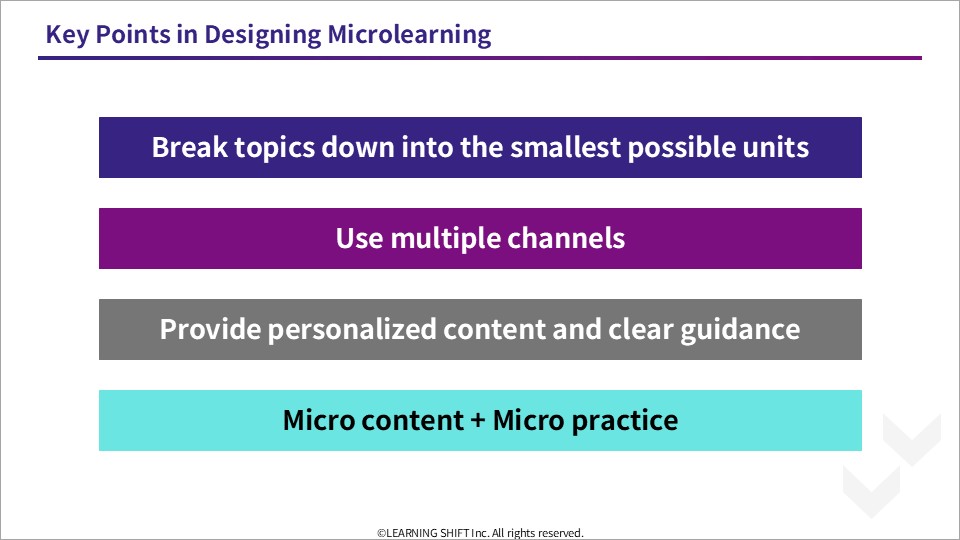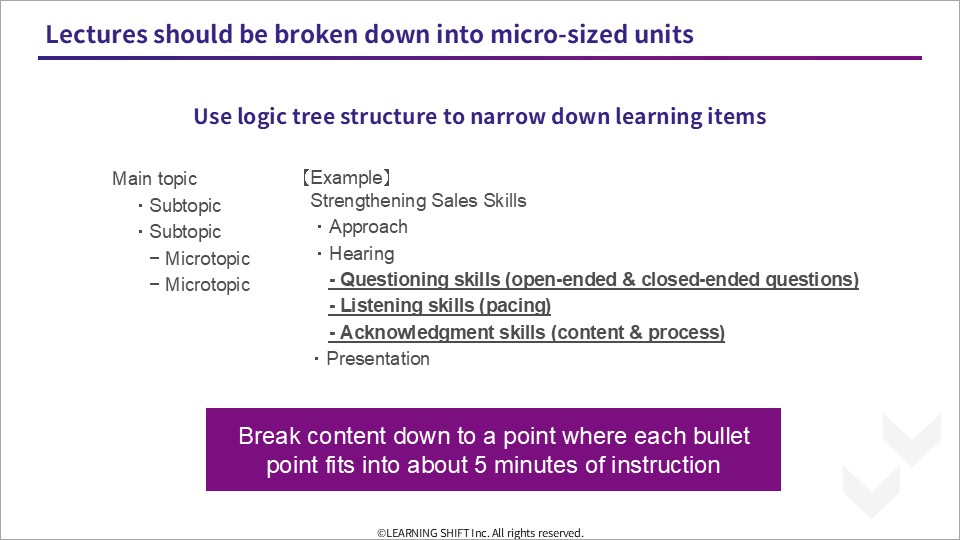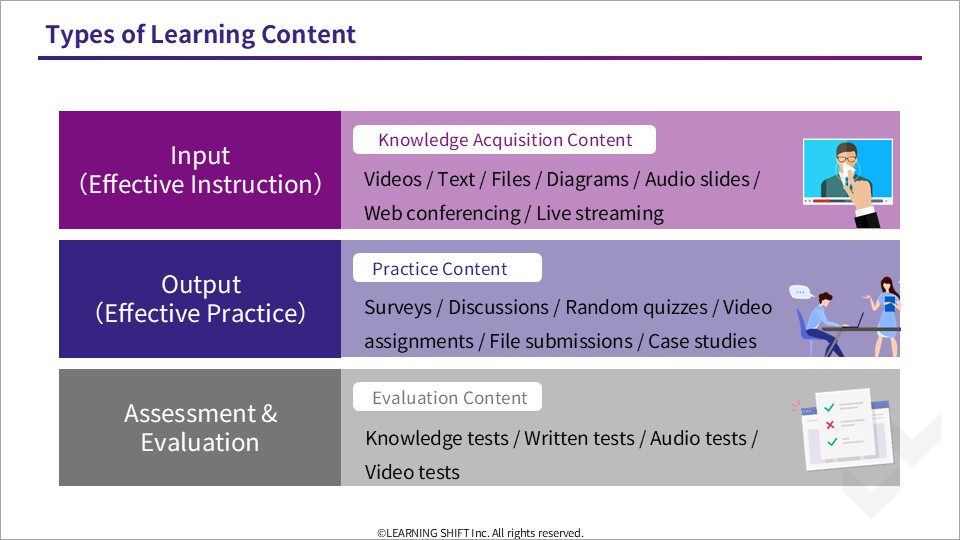2022.02.10
The Essence of Content Knowledge! What Is “Microlearning,” the Key to Creating High-Quality Content?

While we often hear the phrase “creating quality content,” many people may not be sure what exactly should be created—or how. There are several ways to approach an understanding of Content Knowledge, but one of the most important keywords is microlearning.
Since 2017, when Tony Bingham, president of the globally recognized Association for Talent Development (ATD), introduced the concept at an international conference, microlearning has drawn increasing attention in the field of talent development.
As a result, many HR and L&D professionals may have heard the term at least once.
In this article, we will explore microlearning as an aspect of Content Knowledge—its characteristics, and key points for putting it into practice.
1. Why Microlearning is One of the Hottest Trends in Learning Design
Microlearning refers to bite-sized learning, which is often associated with short video clips but is not necessarily limited to video formats.
In the context of blended learning, learning content refers to any element that contributes to achieving learning outcomes, including:
- Videos
- Digital documents
- Articles
- Audio slides
- Infographics
Microlearning structures these content types into small, focused learning units of 5 to 10 minutes to create flexible and effective learning pathways.
Why is Microlearning Essential for Effective Content Development?
Several changes in the learning landscape have driven the demand for microlearning, including:
#1. Growing dissatisfaction with traditional learning methods
#2. Evolving learner expectations
#3. Increased demand for immediacy and efficiency in content creation
#4. Advancements in technology transforming learning environments
#1. Growing Dissatisfaction with Traditional Learning Methods
Traditional corporate training often involved employees sitting in front of a computer for an hour-long session.
However, companies have increasingly encountered challenges such as:
「Limited time available for training due to work constraints」
「Lack of direct relevance and applicability of training content」
Microlearning has emerged as a solution to these issues by making learning more compact and directly applicable to workplace needs.
#2. Evolving Learner Expectations
Learners today have shifted their preference from in-depth, long-form learning to quick and easily accessible learning experiences.
Short, engaging microlearning modules align perfectly with this change in learning behavior.
#3. Increased Demand for Immediacy and Efficiency in Content Creation
L&D professionals face challenges such as:
・Faster content aging, requiring frequent updates
・The need to rapidly develop and deliver learning materials
Microlearning, with its modular and adaptable structure, meets these demands by allowing quick content creation and updates.
#4. Advancements in Technology Transforming Learning Environments
With the widespread adoption of smartphones and tablets, learners can now access training content anytime, anywhere. This flexibility has accelerated the shift toward bite-sized learning, making microlearning an ideal approach.
2. Key Considerations for Implementing Microlearning
When designing microlearning experiences, consider the following four key aspects:

Let’s take a closer look at each key point.
#1. Break Down Topics into the Smallest Logical Units
A 2001 study by Richard Mayer (University of California, Santa Barbara) and Paul Chandler (University of Wollongong, Australia) found that learners who engaged with chunked content demonstrated deeper understanding than those exposed to large blocks of content.
Microlearning aims to provide personalized learning that is delivered at the right time, in the right format. The key is to break down learning content into clear, focused topics that match learners’ cognitive load capacity.
Many people wonder, “How small should chunked content be?”
However, it’s difficult to express the ideal size in terms of time or quantity.
This is because the true guideline is whether the content stays within the learner’s cognitive load—in other words, whether it can be understood without too much effort.
Since cognitive load varies among individuals, it’s hard to define a fixed number.
Content that tends to create high cognitive load typically has the following characteristics:
・Contains a lot of animations, audio, and dense text
・Covers unfamiliar or complex subject matter
・Includes excessively long explanations
However, when the content is simplified—using only images and text, for instance—learners can usually stay focused for up to around 10 minutes.
This means that even with the same length or topic, the cognitive load can be reduced, making the content effectively “chunked” and more digestible.
To help visualize what well-chunked content looks like, the following diagram provides some examples.

When we look at the example of “Strengthening Sales Skills” in the diagram above, we can see that the topic of “Hearing” is broken down further into more specific elements.
A good rule of thumb is to break each item down so that it can be explained in under five minutes.
Although it is difficult to precisely quantify how much content should be segmented, it’s helpful to remember that the key in microlearning design is to reduce each unit to a size that doesn’t overload our cognitive capacity.
#2. Utilize Multiple Learning Channels
Using multiple sensory channels enhances learning effectiveness. Studies show that combining visual and auditory inputs improves retention compared to using either modality alone.
Microlearning should incorporate various content types such as videos, images, text, and voice-over to create a more engaging and immersive experience.
#3. Personalize Content and Provide Clear Guidance
Maintaining learner engagement requires personalized and contextually relevant content. Strategies include:
・Addressing learners directly (e.g., using “you” statements)
・Providing clear next steps to guide learners through their journey
By designing content that speaks directly to the learner’s needs and challenges, engagement and motivation levels improve significantly.
#4. Incorporate Microcontent and Micropractice
One of the most critical elements of microlearning is balancing content delivery (input) with active practice (output).
Microlearning is often misunderstood as being purely content consumption (e.g., watching short videos). However, true learning happens when learners apply what they learn.
Effective microlearning strategies include:
・Encouraging learners to articulate their understanding (e.g., summarizing insights, answering discussion prompts)
・Interactive exercises such as quizzes and role-playing activities
・Practical assignments that require learners to submit outputs for review and feedback
Without practical application, learning remains passive and is less likely to result in behavioral change or skill acquisition.
3. Types of Content to Blend in a Blended Learning Approach

When blending content in a blended learning program, it is important to prepare each type of content in advance.
As explained in the previous section, the combination of input and output is essential for putting “learning” into practice.
In addition, assessment content that evaluates whether learners have practiced effectively is equally important.
For example, a training program incorporating three types of content might follow this flow:
①Learners watch a short video (around 5 minutes) to gain new knowledge or skills. (Input)
②Learners submit a file related to the topic. (Output)
③Learners provide peer feedback by commenting on each other’s submissions. (Output)
④A written test is conducted to assess the learner’s understanding. (Evaluation)
Effective learning cannot occur if any of the three—Input, Output, or Evaluation—is missing.
When designing a training program, it’s helpful to use these three types as a checklist to ensure that the learning experience is well-rounded.
4. Conclusion:Four Key Considerations for Effective Microlearning Implementation!

As a result, there is increasing demand for short, practical learning experiences—needs that microlearning is well-suited to address.
To design an effective microlearning strategy, remember these four key principles:
①Break down topics into the smallest logical units
②Utilize multiple learning channels
③Personalize content and provide clear guidance
④Incorporate microcontent and micropractice
By implementing these best practices, organizations can create impactful, engaging, and results-driven learning experiences that meet modern business and learner needs.